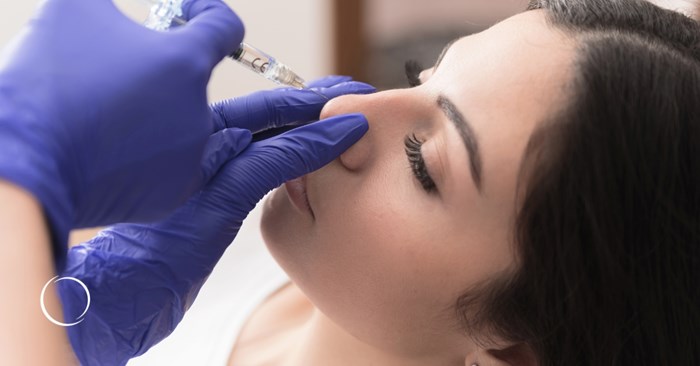The ideal patient for nonsurgical rhinoplasty

Thinking of tweaking your nose but want to skip the surgery? Nonsurgical rhinoplasty might sound like the perfect fix – no scalpels, no downtime, just a few quick injections. However, not everyone is a good fit for this procedure. The difference between a subtle enhancement and majorly missing the mark is understanding who the ideal candidate is. Your nose can quickly become the center of attention in a negative way when it is crooked or not sized and shaped properly to complement the rest of your facial features.
So, how do you know if you're an ideal candidate for nonsurgical rhinoplasty? How do you go about finding the right surgeon to help you reach your goals? To answer these questions and more about identifying what type of rhinoplasty is right for you, we spoke with ASPS Member Surgeon Richard Reish, MD, FACS.
The basics of nonsurgical rhinoplasty
Nonsurgical rhinoplasty is less invasive than traditional rhinoplasty. It often uses fillers or threads to improve the shape and overall appearance of the nose without an operation.
"It is essentially injecting hyaluronic acid fillers into the nose and is most often used to disguise a dorsal hump (a prominent bump on the bridge of the nose)," said Dr. Reish. "The goal is to try to inject above and below the hump to balance it out and improve the appearance."
This outpatient procedure has immediately visible results without the extensive recovery period that comes with surgical rhinoplasty. There may be some light bruising at the site of injection for a few days, but this will fade away quickly, revealing a more aesthetically pleasing nose shape beneath.
Candidates for nonsurgical rhinoplasty
The idea of a quick, no-knife nose job might be appealing, but it's only right for a small group of people with specific issues.
"A bad candidate often has a high dorsum and a high-set radix (where the nose connects to the forehead), potentially with an overprojected tip," said Dr. Reish. "With these patients, providers who perform nonsurgical rhinoplasty will end up filling above the hump, blending the forehead into the nose. This gives patients what I call the 'avatar nose.' Yes, the dorsal hump is gone, but the nose has gotten much larger and, quite frankly, looks worse than before the provider injected it with filler."
So, what type of nose is best for nonsurgical rhinoplasty?
"There are very few patients out there that are actually good candidates," said Dr. Reish. "They usually have a low radix with a low-set dorsal hump and lower dorsal tip."
That doesn't mean you're out of options if you're not a match.
"Most patients are actually just much better options for surgical rhinoplasty, but, unfortunately, are not offered that option by some providers," said Dr. Reish.
If you're still interested in changing your nose, a surgical rhinoplasty might be a more effective way to achieve your desired look.
Red flags for a nonsurgical rhinoplasty
Once you know you're a good match for nonsurgical rhinoplasty, the next step is to find the right surgeon to perform the procedure. At this point, it's critical to watch for red flags that could mean the doctor isn't the right match.
"Here's the major issue with nonsurgical rhinoplasty – most providers don't know who the appropriate patient is," said Dr. Reish. "Many will have a hammer and see every patient as a nail. In other words, even if they're not a great candidate for nonsurgical rhinoplasty, they'll offer it up as a treatment option."
You might find another red flag in the surgeon's social media.
"Some providers will try to disguise the 'avatar look' on their social media before and after photos," said Dr. Reish. "They'll show the preop photos in a true lateral (side) feature, but any post-injection photos are never a true lateral view. In fact, they're often slightly off lateral to disguise the results. This is very deceptive to patients. The results should be shown in a true lateral view. In addition, many of these 'after' photos are taken immediately following the procedure, not showing the long-term results."
Surgical rhinoplasty following nonsurgical rhinoplasty
Patients who are looking for an immediate nonsurgical fix but want to keep their options open for a full rhinoplasty later on, that's a possibility.
"A common question that always arises with nonsurgical rhinoplasty is what patients can do if they decide to go on to pursue actual surgical rhinoplasty," said Dr. Reish. "They either realize they don't like the overall look, or they want a smaller version of their nose. Many surgeons will recommend having nonsurgical rhinoplasty filler dissolved prior to surgery, but I don't find that necessary. I'll often open up the nose and remove the filler during surgery. It's very easy to locate and identify."
For any patient who is considering changing the appearance of their nose, rhinoplasty is an excellent, proven option to achieve amazing results. And for those who are reluctant to have surgery, nonsurgical rhinoplasty via fillers or dissolvable threads is an excellent alternative, if they are the right fit. Consult with a board-certified plastic surgeon who is an ASPS member to explore your options.
To find a qualified plastic surgeon for any cosmetic or reconstructive procedure, consult a member of the American Society of Plastic Surgeons. All ASPS members are board certified by the American Board of Plastic Surgery, have completed an accredited plastic surgery training program, practice in accredited facilities and follow strict standards of safety and ethics. Find an ASPS member in your area.
